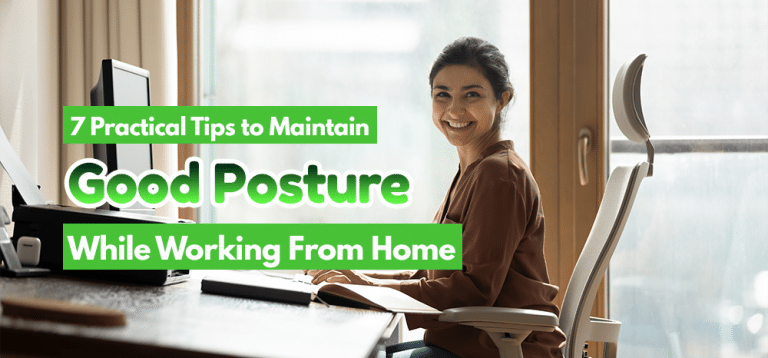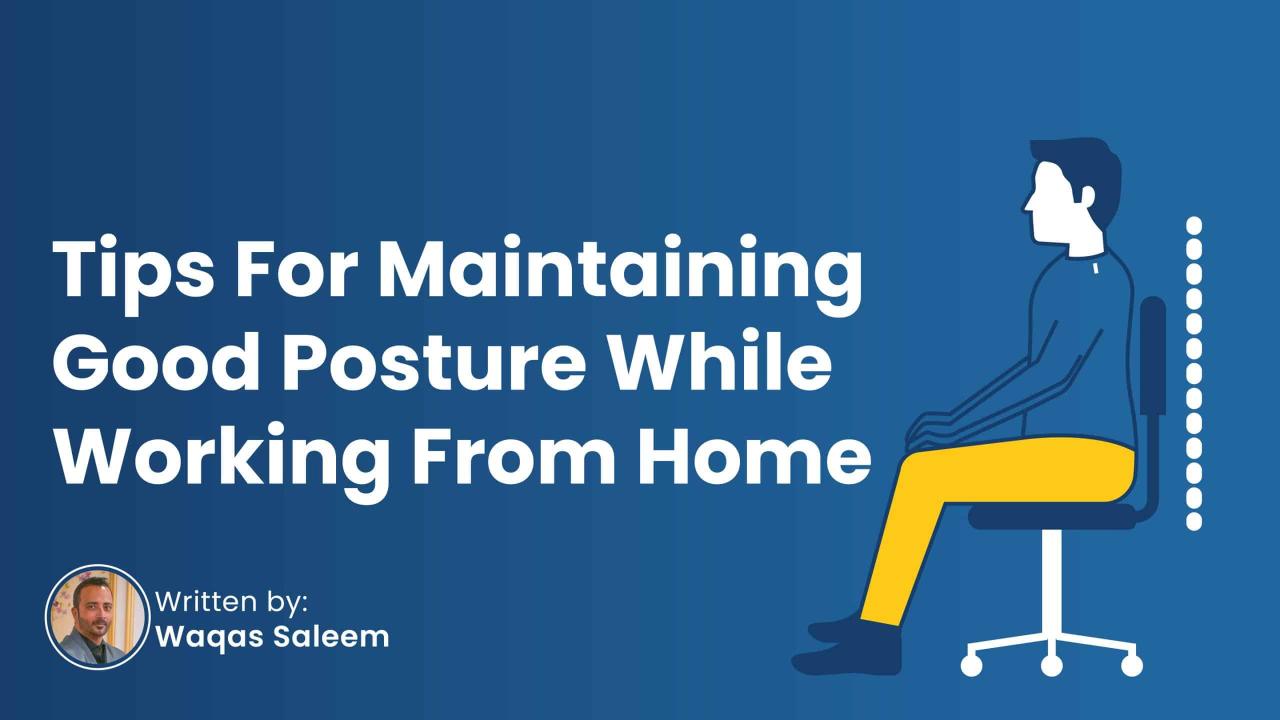Work-from-home health tips for better posture: A Guide to Improving Your Well-being
Work-from-home health tips for better posture sets the stage for this enthralling narrative, offering readers a glimpse into a story that is rich in detail with casual formal language style and brimming with originality from the outset.
In today's fast-paced work environment, maintaining good posture is crucial for overall health and well-being. This guide will provide insights on how to enhance your posture while working from home, ensuring a healthier lifestyle.
Importance of Good Posture

Good posture is crucial for maintaining overall health and well-being. When you sit or stand with proper alignment, it helps reduce strain on your muscles, joints, and ligaments, leading to decreased risk of pain and injury.
Effects of Poor Posture
Poor posture, on the other hand, can contribute to a variety of health issues. It can lead to back and neck pain, headaches, muscle stiffness, and even poor circulation. Over time, chronic poor posture may result in long-term complications such as spinal misalignment and decreased lung capacity.
Benefits of Good Posture while Working from Home
- Improved breathing and circulation: Sitting or standing with good posture allows for better lung function and blood flow throughout the body.
- Reduced pain and discomfort: Maintaining proper alignment can help alleviate tension in the neck, shoulders, and lower back.
- Enhanced productivity and focus: Good posture promotes better concentration and energy levels, making it easier to stay engaged and efficient while working.
- Prevention of musculoskeletal issues: By practicing good posture habits, you can reduce the risk of developing musculoskeletal problems in the future.
Ergonomic Workspace Setup

To maintain good posture while working from home, it is crucial to set up an ergonomic workspace that promotes proper alignment of the body. This not only helps prevent strain and discomfort but also improves overall productivity and focus.
Correct Positioning of Equipment
- Position the top of your computer screen at or slightly below eye level to reduce strain on your neck.
- Place the keyboard and mouse within easy reach, with your elbows close to your body and bent at a 90-degree angle.
- Ensure your chair is adjusted so that your feet are flat on the floor, and your thighs are parallel to the ground.
Importance of Supportive Chair and Proper Lighting
- Invest in a chair with good lumbar support to maintain the natural curve of your spine.
- Adjust the height of your chair so that your forearms are parallel to the ground when typing.
- Ensure your workspace is well-lit to reduce eye strain and maintain focus on your tasks.
Stretching and Exercise Routine
Incorporating stretching and exercise into your work-from-home routine can greatly benefit your posture and overall health.
Simple Stretching Exercises
- Neck Rolls: Gently roll your neck in a circular motion, first clockwise and then counterclockwise, to relieve tension in the neck and shoulders.
- Shoulder Shrugs: Lift your shoulders up towards your ears, hold for a few seconds, and then release. Repeat several times to release tension in the shoulders.
- Back Extensions: Stand up straight, place your hands on your lower back, and gently arch backwards to stretch the back muscles.
Importance of Regular Breaks
It is essential to take regular breaks throughout the workday to stretch and move around. Sitting for prolonged periods can lead to muscle stiffness and poor posture.
Strengthening Core Muscles
- Planks: Hold a plank position for 30 seconds to 1 minute to strengthen your core muscles, which are essential for maintaining good posture.
- Leg Raises: Lie on your back and lift your legs up towards the ceiling, engaging your core muscles. Slowly lower your legs back down without touching the floor.
- Bridge Exercise: Lie on your back with your knees bent and lift your hips off the ground, engaging your glutes and core muscles to improve lower back support.
Mindful Work Habits

Taking short breaks throughout the workday is crucial for resting your eyes and preventing eye strain. Staring at a screen for extended periods can lead to discomfort and potential long-term vision issues. It's recommended to follow the 20-20-20 rule: every 20 minutes, look at something 20 feet away for at least 20 seconds to reduce eye strain.
Practicing Mindfulness and Relaxation Techniques
- Incorporate deep breathing exercises into your daily routine to reduce stress and tension in your body.
- Practice mindfulness by focusing on your breath and being present in the moment, which can help improve your posture and overall well-being.
- Consider setting up a designated relaxation space in your workspace where you can take short breaks to rejuvenate your mind and body.
Benefits of Maintaining a Consistent Work Schedule
- Establishing a routine helps create a sense of structure and stability in your workday, leading to increased productivity and efficiency.
- Setting boundaries between work and personal time promotes a healthy work-life balance, reducing the risk of burnout and improving your mental health.
- Consistency in your work schedule allows for better time management, ensuring you have dedicated breaks to rest and recharge throughout the day.
End of Discussion
In conclusion, prioritizing good posture while working from home can significantly impact your health and productivity. By implementing the tips and techniques discussed, you can create a more ergonomic and comfortable workspace, ultimately leading to a better quality of life.
Essential FAQs
How important is good posture for overall health?
Good posture is essential for maintaining the natural curves of the spine, reducing strain on muscles, and preventing musculoskeletal issues.
What are some simple stretching exercises to improve posture?
Exercises like shoulder rolls, chest stretches, and seated twists can help improve flexibility and posture.
How can mindfulness practices help in maintaining better posture?
Practicing mindfulness can reduce stress levels, which in turn can help you maintain a relaxed and upright posture throughout the day.




